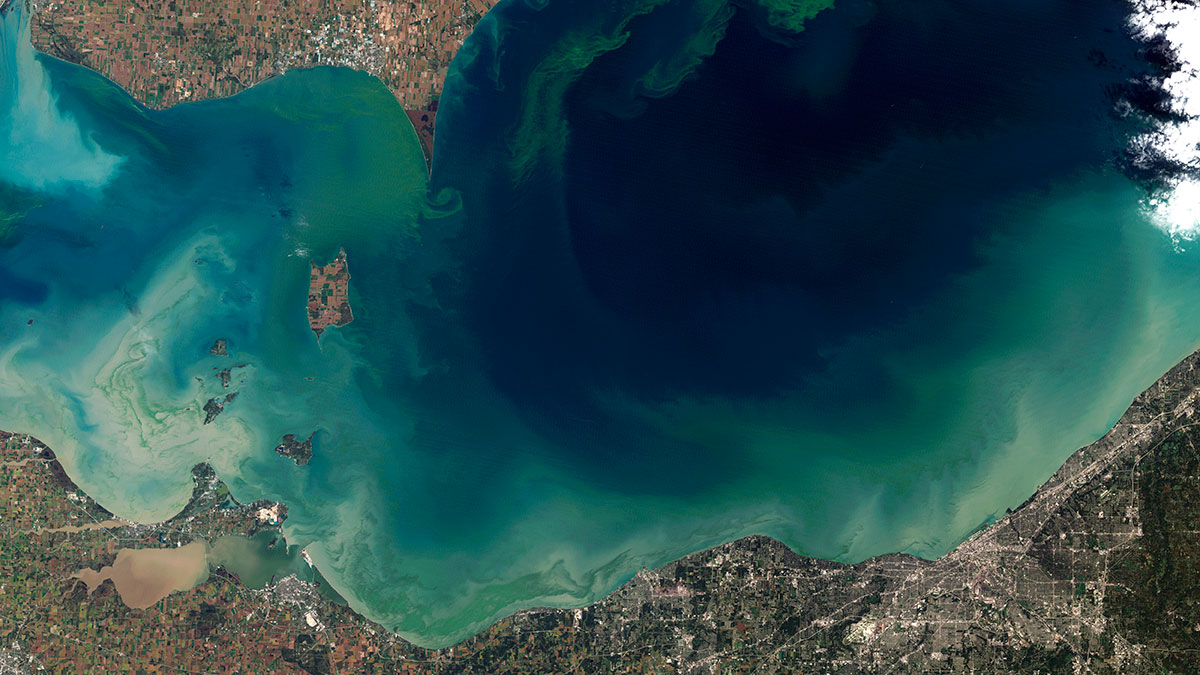Algae form the basis for many aquatic food webs, but when certain algae, bacteria, or other tiny photosynthetic organisms start to grow out of control—a phenomenon called an algal bloom—they can cause major problems. Harmful algal blooms (HABs) disrupt ecosystems, negatively affect drinking water supplies, and threaten human health worldwide, costing an estimated $4 billion per year in the United States alone, said Tyler King, a hydrologist at the U.S. Geological Survey’s (USGS) Idaho Water Science Center.
Because of the sheer scale of the problem, HABs are difficult to monitor from the ground, so scientists are working on ways to more effectively monitor them from space. Currently, scientists, including those at the U.S. interagency Cyanobacteria Assessment Network (CyAN) project, are working on using satellite images to identify and monitor the spread of algal blooms that involve cyanobacteria, which can be particularly problematic.
But there are many, many types of microbes associated with HABs—even the term cyanobacteria encompasses thousands of species—and available technology isn’t very good at telling them apart using satellite data. This is important because although many species are relatively benign (at least in terms of danger to human health), blooms of certain species produce potent toxins that affect the nervous system or liver. Determining whether a bloom is made up of these dangerous species is a key part of creating an effective management plan to protect people from the negative effects of the bloom.
Scientists at USGS, including King, are hard at work on this problem, developing a technique called Spectral Mixture Analysis for Surveillance of Harmful Algal Blooms (SMASH) that they hope will one day allow us to determine the type of microbe in a bloom from satellite images. The scientists will present their research on 13 December at AGU’s Fall Meeting 2021.
For now, said Carl Legleiter, a hydrologist at the USGS Geomorphology and Sediment Transport Laboratory and one of the scientists working on the SMASH technique, the research is still in the proof-of-concept stage. Currently, he said, researchers are working on creating a spectral library—a set of reflectance characteristics for various microbes, measured using a microscope and a hyperspectral camera. Using this library, along with the reflectance of the water in a lake, they try to identify the best match for an algal bloom in a satellite image. Early successes included identifying blooms of the freshwater cyanobacteria Microcystis and Aphanizomenon (both of which can produce toxins damaging to human health) in lakes in New York and Oregon, respectively.
Other specialists in remote sensing of algal blooms are also enthusiastic about the technique. “It would be great if you could get more specific about what type of plankton is in the system,” said Bridget Seegers, the NASA lead scientist on the CyAN project, who was not involved in developing the SMASH technique.
Preparing for the Future
Right now, most satellites aren’t capable of gathering the hyperspectral images needed for this kind of analysis. The SMASH technique uses data collected by a device on the International Space Station, which, said Legleiter, means the coverage is limited. But it won’t be this way forever. “There are multiple hyperspectral satellites slated for launch in the coming years,” he said.
Techniques like SMASH, said Seegers, “are good prep for the kind of satellites that are coming.”
In the meantime, researchers will be busy adding more species to the spectral library and trying out the SMASH technique in more lakes across the United States.
The problem of algal blooms “is going to only increase in significance in the future because one of the risk factors is elevated water temperatures.”
The problem of algal blooms, said Legleiter, “is going to only increase in significance in the future because one of the risk factors is elevated water temperatures. You may have heard—things are warming up on this planet. And another potential driver is nutrient enrichment from agricultural runoff. So changes in land use and poor soil management practices, those kinds of things, can also be contributors.”
Indeed, a 2019 study showed that globally, freshwater blooms have generally become more intense over the past few decades. Seegers said that currently, efforts are focused on improving our ability to monitor these blooms in near-real time. However, tracking the prevalence of blooms in a specific location over time might enable researchers to identify local changes (like differences in land use or agricultural practices) associated with increased blooms, which could help identify ways to prevent them in the future. The more we understand about harmful algal blooms—which species are involved, the conditions that precipitate them—the better we’ll be able to address this global problem.
—Hannah Thomasy (@HannahThomasy), Science Writer
This news article is included in our ENGAGE resource for educators seeking science news for their classroom lessons. Browse all ENGAGE articles, and share with your fellow educators how you integrated the article into an activity in the comments section below.



